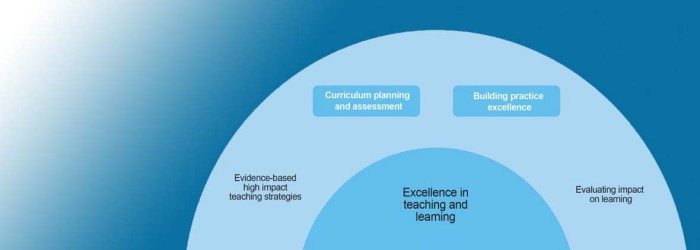The foundation of teaching and learning are curriculum, instruction, assessment and feedback:
- Curriculum – what we teach
- Instruction – how we teach
- Assessment – how do we know that it has been learnt
- Feedback – how do we engage students with their learning
Successful schools have a guarenteed and viable curriculum with student needs at the centre, high quality teaching and learning practises with an agreed instructional model, and a professional learning community approach where there is shared responsibility for student learning and improvement.
Build the guaranteed and viable curriculum.
At MPPS we have a guaranteed and viable curriculum in terms of a documented curriculum based on the Victorian Curriculum that teachers know, are teaching and assessing. We are building and developing the curriculum so that:
- Teachers have deeper knowledge of the scope of the curriculum and sequence of learning (from Foundation to year 7 and beyond).
- Teams are ensuring that the amount of content in the curriculum is teachable in the time available for instruction.
- Student data is used to develop a curriculum that reflects the needs of the cohort.
- There is:
- fidelity between the curriculum documentation and what is being taught and assessed,
- consistency across teams and
- alignment across the school
Build the instructional practice of every teacher so that there is consistency and high quality across the school.
At MPPS there has been professional development to support high quality teaching. As a school, we have an agreed instructional approach based on the work of Prof. Jane Pollock. Our continued focus is on ensuring that the implementation of our instructional model has fidelity, intensity and consistency. Also, that the conditions for learning are evident in every classroom. Finally, it is about ensuring that there is consistency in each class as you move through the school.
Good learners have the ability to remember and understand what they have learnt. The high yield strategies as research-based strategies have been identified as having a high probability of enhancing student achievement for all students, in all subject areas, at all year levels. When learners use these strategies, they are engaged with the purpose for learning, able to connect new information to prior learning and embed this knowledge or skills. At MPPS, teachers plan for the high yield strategies as part of our instructional model/curriculum planning.
Build the professional learning communities (PLC’s) across the school.
At MPPS we have a strong PLC culture. Working collaboratively is an embedded expectation of all staff and is supported through the timetable and meeting structure. The work of PLC’s is to meet the needs of and develop collective responsibility for all students. This is done through strong distributed leadership across the school, teamwork and monitoring of high expectations and accountability for the learning and engagement of every student.
Resources to support Excellence in Teaching and Learning:
| Curriculum | Instruction, Assessment, Feedback |
| Visual – MPPS Curriculum Planning Flow Chart Literacy Expectations Numeracy Expectations English Scope and Sequence Maths Scope and Sequence Integrated Scope and Sequence Specialist Scope and Sequence Digital Literacy/ICT Scope and Sequence Developmental Play program First 20 Days of School – Literacy program First 20 Days of School – Numeracy program First days of CAFE – Literacy MPPS Reading Workshop Classroom Learning Environment Establishing a Numeracy Classroom |
GANAG – Instructional Model information (including high yield strategies) Planning templates · Yearly Planner · Term Overview · GANAG Unit Planner · Weekly Planner MPPS Assessment Guidelines English Moderation Document Maths Moderation Document Live Scoring Professional Learning Communities (PLC) overview Professional Reading FUSE – Vic Curriculum online resource |
